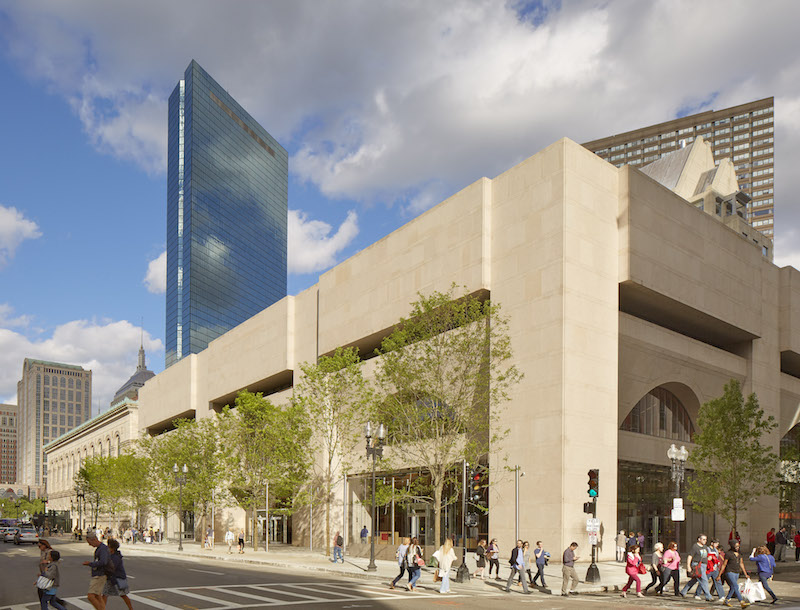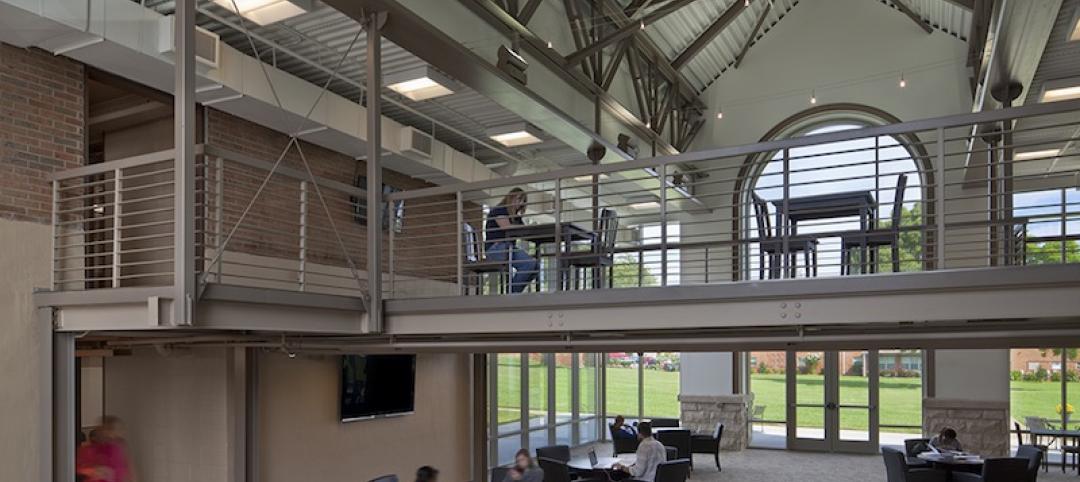About 1.5 million people visited the Boston Public Library between July 2016 and March 2017. That’s a 22% increase over what the library drew from July 2015 through March 2016.
That bump was attributable, in large measure, to the library’s $78 million renovation, the results of which debuted in July 2016. This three-year-long project, lead by William Rawn Associates | Architects and Consigli Construction, opened up and brightened what, by consensus, had been an uninviting space for patrons, disconnected from its Copley Square neighborhood.
The renovation—whose numerous accolades include, most recently, the 2017 Preservation Massachusetts, Paul and Niki Tsongas Award—achieved that goal in several ways.
Most notably, it created a 35-ft-wide, 210-ft-long connection between Johnson Building—a building designed by architect Phillip Johnson and opened in 1972—and the McKim Building, designed by Charles McKim and opened in 1892. Johnson was on record saying that he was never satisfied with the way the entrance and lobby to his building turned out. Neither were visitors who often found themselves wandering through labyrinthine corridors to get from one part of the library to the other.
“People were always getting lost,” said Cliff Gayley, a Partner with William Rawn Associates, who with Sindu Meier, a Senior Associate of the firm; and Phil Brault, Senior Project Manager with Consigli, recently spoke with BD+C about their work on transforming the library.
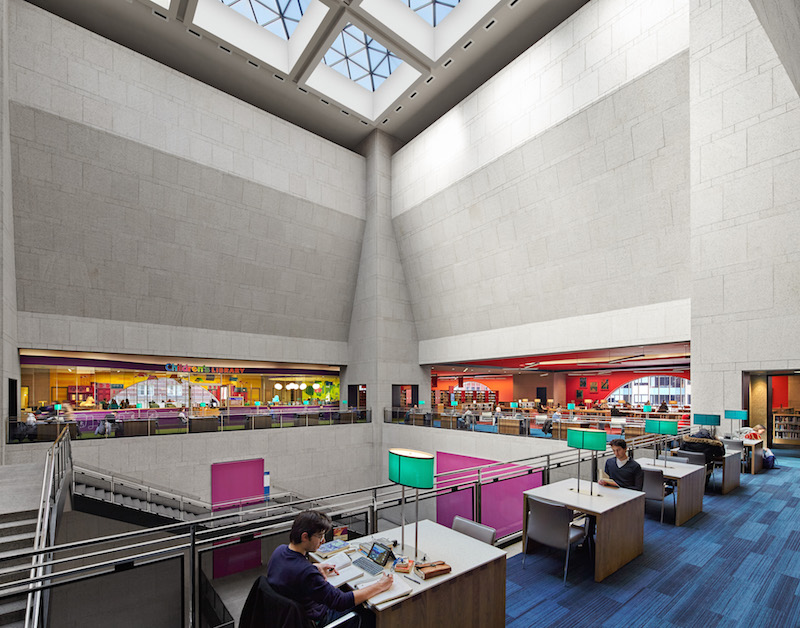 The second-floor renovation of Boston's Central Library doubled the size of the Children's library, and created quiet reading spaces around its periphery. The library's atrium, Deferrari Hall, provides ample natural sunlight. Image: Robert Benson Photography.
The second-floor renovation of Boston's Central Library doubled the size of the Children's library, and created quiet reading spaces around its periphery. The library's atrium, Deferrari Hall, provides ample natural sunlight. Image: Robert Benson Photography.
The master plan for this landmark library’s overhaul was drawn up in 2012, soon after which “it became clear very quickly that the building had been designed for a different time,” recalled Meier.
To create a more logistically elegant pathway between the two buildings, the Building Team needed to support the McKim Building’s load-bearing but fragile masonry wall with structural framing and shoring that could withstand a load of over 1 million pounds.
The team devised a steel framing system, preloaded with hydraulic jacks, which allowed for the removal of two concrete columns below the second floor that each handled a load of over 300,000 pounds.
The renovation also removed ugly tinted windows that offered virtually no outside view, as well as 97 granite plinths that formed a barrier around the Johnson building. In their place is a more amenable façade of two-story-high windows that, at ground level, is flush with the sidewalk, making the building appear more approachable from the street.
A movable tunnel system from Boylston Street allowed the library to stay open during construction. The Building Team hauled in building materials through second-floor windows during the renovation, which was conducted in two phases
The first, which was completed in February 2015, spruced up the second floor by doubling the size of the Children’s library, introducing a maker space for teenagers, and creating reading and classroom areas around the perimeter.
Phase two, completed in the summer of 2016, revitalized the lower floor’s Kirsten Business Library and Innovation Center. The entrance to the newly created two-story Boylston Hall offers a Welcome Center and circulation desk (moved back about 75 feet from the door, said Gayley), with informational touch screens that, among other things, allow visitors to peruse the library’s digital catalog.
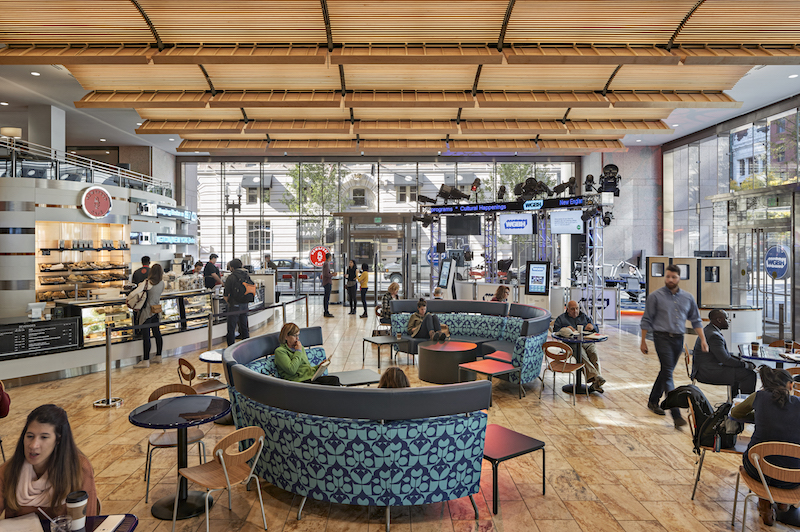
The newly created Boylston Hall leads visitors to a glass-enclosed area with a cafe and a satellite studio for WGBH. It was important to library officials that the renovation include a retail component. Image: Robert Benson Photography
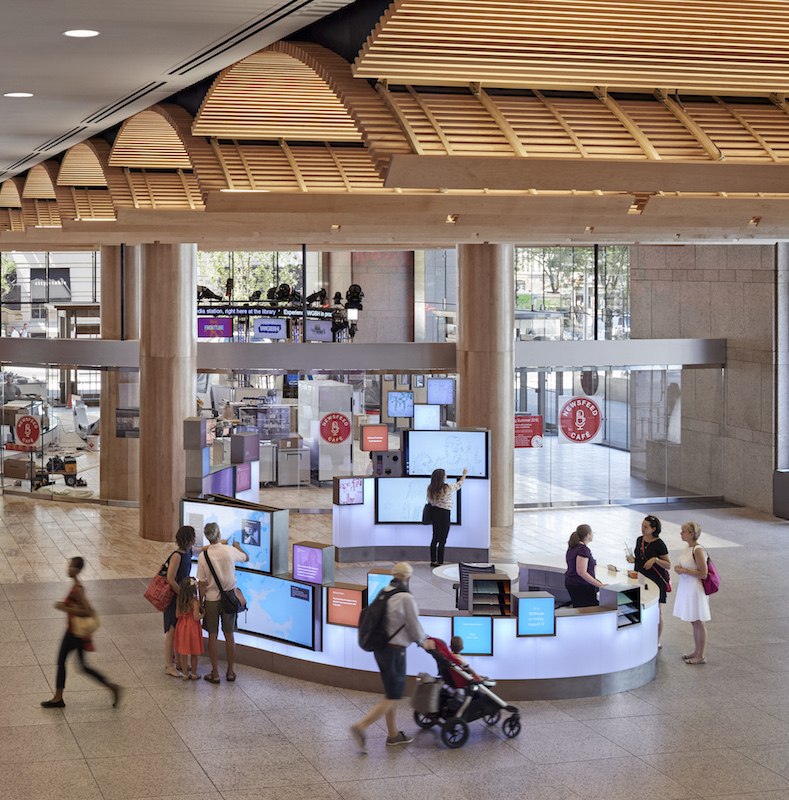 A Welcome Center at the library's entrance offers a digital experience to visitors. Image: Robert Benson Photography
A Welcome Center at the library's entrance offers a digital experience to visitors. Image: Robert Benson Photography
That Boylston Street entrance, encompassed by glass, leads visitors to the library’s Newsfeed Café, managed by Catered Affair; as well as a “new and novel” section for fiction and nonfiction, and a satellite television studio for WGBH, Boston’s public station. “Libraries are struggling to remain relevant, and this project exhibits forward thinking and entrepreneurship,” observed Brault. A fetching curved wood-slatted ceiling accents this area.
A total of 156,000 sf were added or improved by this renovation, which included making activities on each floor visible and transparent via Deferrari Hall, the Central Library’s striking atrium, which bathes its more-open and colorful spaces in natural light from the library’s roof.
Related Stories
| Jan 13, 2014
Custom exterior fabricator A. Zahner unveils free façade design software for architects
The web-based tool uses the company's factory floor like "a massive rapid prototype machine,” allowing designers to manipulate designs on the fly based on cost and other factors, according to CEO/President Bill Zahner.
| Jan 11, 2014
Getting to net-zero energy with brick masonry construction [AIA course]
When targeting net-zero energy performance, AEC professionals are advised to tackle energy demand first. This AIA course covers brick masonry's role in reducing energy consumption in buildings.
Smart Buildings | Jan 7, 2014
9 mega redevelopments poised to transform the urban landscape
Slowed by the recession—and often by protracted negotiations—some big redevelopment plans are now moving ahead. Here’s a sampling of nine major mixed-use projects throughout the country.
| Dec 13, 2013
Safe and sound: 10 solutions for fire and life safety
From a dual fire-CO detector to an aspiration-sensing fire alarm, BD+C editors present a roundup of new fire and life safety products and technologies.
| Dec 10, 2013
16 great solutions for architects, engineers, and contractors
From a crowd-funded smart shovel to a why-didn’t-someone-do-this-sooner scheme for managing traffic in public restrooms, these ideas are noteworthy for creative problem-solving. Here are some of the most intriguing innovations the BD+C community has brought to our attention this year.
| Dec 9, 2013
Tips for designing higher education's newest building type: the learning commons
In this era of scaled-down budgets, maximized efficiencies, new learning methods and social media’s domination of face time, college and university campuses are gravitating toward a new space type: the learning commons.
| Nov 27, 2013
Wonder walls: 13 choices for the building envelope
BD+C editors present a roundup of the latest technologies and applications in exterior wall systems, from a tapered metal wall installation in Oklahoma to a textured precast concrete solution in North Carolina.
| Nov 26, 2013
Construction costs rise for 22nd straight month in November
Construction costs in North America rose for the 22nd consecutive month in November as labor costs continued to increase, amid growing industry concern over the tight availability of skilled workers.
| Nov 25, 2013
Building Teams need to help owners avoid 'operational stray'
"Operational stray" occurs when a building’s MEP systems don’t work the way they should. Even the most well-designed and constructed building can stray from perfection—and that can cost the owner a ton in unnecessary utility costs. But help is on the way.
| Nov 19, 2013
Top 10 green building products for 2014
Assa Abloy's power-over-ethernet access-control locks and Schüco's retrofit façade system are among the products to make BuildingGreen Inc.'s annual Top-10 Green Building Products list.


